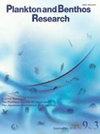圣乔治湾(巴塔哥尼亚)周围渔场春季和夏季的初级生产和浮游生物组合
IF 0.9
4区 生物学
Q4 MARINE & FRESHWATER BIOLOGY
引用次数: 2
摘要
:圣乔治湾及其北部沿海地区是阿根廷最重要的渔场之一。然而,浮游植物的生产却很少被研究。在这里,我们分析了春季(2008年)和夏季(2009年)浮游植物的生物量、产量以及浮游植物和原浮游动物的组成;它们可能的营养关系和物理条件。春季,在海湾南海岸,微纳浮游生物(硅藻和恐龙)占主导地位,并负责最大的综合产量,与阿根廷丰富的陆架断裂的报告相当。那里产生的部分有机碳被异养恐龙消耗,为食物网增加了营养水平。而在海湾的中心,一个明显的深煌斑岩极大值可能会向底部添加有机物。在接下来的夏天(2009年),超部分对浮游植物总生物量的贡献最大,并以聚球藻属为主。这加上纤毛虫的丰度,表明夏季微生物食物网的普遍性。研究发现,海湾北部和南部的锋面区由于初级生产力高,有利于浮游植物的高生物量及其维持,为春季怀孕的雌虾和夏季的幼虫提供了有利的食物环境。本文章由计算机程序翻译,如有差异,请以英文原文为准。
Primary production and plankton assemblages in the fisheries ground around San Jorge Gulf (Patagonia) during spring and summer
: The San Jorge Gulf, and the littoral to its north, is one of the most important fishing grounds for Argentina. Nevertheless, phytoplankton production has been scarcely studied. Here we analyzed during spring (2008) and summer (2009) the phytoplankton biomass, production, and the composition of phytoplankton and protozooplankton; their pos sible trophic relationships, and physical conditioners. At the south coast of the gulf during spring micro-nano-plankton (diatoms and dinoflagellates) were predominant and responsible for the maximum integrated production, comparable to that reported for the rich Argentinian shelf-break. Part of the organic carbon produced there was consumed by hetero trophic dinoflagellates, adding a trophic level to the food web. While at the center of the gulf, a conspicuous deep chlo rophyll maximum would probably add organic matter to the bottom. During the following summer (2009), the ultra-fraction represented the largest contribution to total phytoplankton biomass, and was dominated by Synechococcus sp. This, plus the abundance of ciliates, indicate the prevalence of a microbial food web during summer. It has been found that the frontal zones in the north and south of the gulf, favoring high phytoplankton biomass and its maintenance due to high primary production, provide a favorable food environment for impregnated female shrimp in spring, and for lar vae during summer.
求助全文
通过发布文献求助,成功后即可免费获取论文全文。
去求助
来源期刊

Plankton & Benthos Research
Agricultural and Biological Sciences-Aquatic Science
CiteScore
1.30
自引率
0.00%
发文量
32
期刊介绍:
Plankton and Benthos Research is a peer-reviewed journal publishing quarterly original papers, reviews and notes dealing with any aspect of the biology and ecology of planktonic and benthic organisms and their interactions with the environment in any aquatic system, and is open to all scientists around the world. Submission of a paper is held to imply that it represents an original contribution not previously published and that it is not being considered elsewhere.
 求助内容:
求助内容: 应助结果提醒方式:
应助结果提醒方式:


